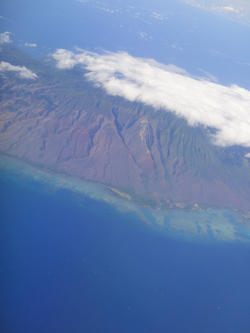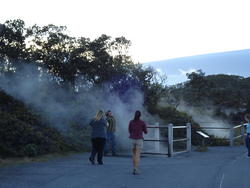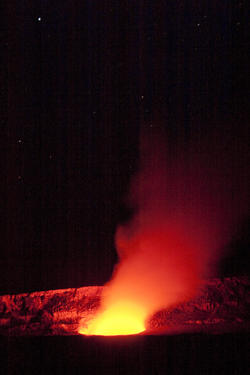Starting in San Diego we headed out to Hawaii and got our first glimpse of the volcano. From the steaming bluffs to the lava lake at night, our first day was a remarkable example of what is in store!
San Diego International Airport
 After three days of intensive lectures in the IGPP at Scripps, some of us gathered at the airport to fly out to Honolulu.
After three days of intensive lectures in the IGPP at Scripps, some of us gathered at the airport to fly out to Honolulu.
Flying into Honolulu from the North of the Islands, we saw the majestic Mauna Loa shield far left from the airplane window. We met others who were transiting to San Francisco, Los Angeles or coming from there after the five hours of flight. Most of us had the same flight out to Hilo from Honolulu in the afternoon and spent our time having some food, chatting and chasing birds in the departure hall.
From Hilo to Honolulu
 On the way to the big island, we had the Hawaiian Islands on our left. To our advantages, a few of us with the window seats managed to see some geological features from the birds’ eye view. Firstly, we saw the Diamond Head crater on the southern tip of the O’ahu, not too far from Honolulu. According to the Hawaiian State Parks, this cinder cone was formed roughly 300,000 years ago due to a single explosive eruption.
On the way to the big island, we had the Hawaiian Islands on our left. To our advantages, a few of us with the window seats managed to see some geological features from the birds’ eye view. Firstly, we saw the Diamond Head crater on the southern tip of the O’ahu, not too far from Honolulu. According to the Hawaiian State Parks, this cinder cone was formed roughly 300,000 years ago due to a single explosive eruption.
Continuing on towards Hilo, we saw the island of Moloka’i with the Moloka’I Forest Reserve. Later on, Maui came into sight with the Lahaina coastline and the West Maui Forest Reserve. Towards the south of the island, low clouds are moving up to the Haleakala Crater from the Northwest. On the descent towards Hilo, the Big Island was on our left and the Hilo Bay came into sight as we landed. After settling the rental vans, we did our groceries at KTA supermarket along Highway 11 in Hilo before heading to the Steaming bluff on the way to Kilauea Military Camp.
Steaming Bluffs

Volcano National Park, HI
 The group was staying at the Kilauea Military Camp (KMC). After settling in at KMC and having a bite to eat the group set out for what would be the highlight of the day. We drove a short distance to the volcano observatory. By this time it was quite dark and there was little moonlight. In the darkness we carefully made our way from the parking lot to the overlook of Halemaʻumaʻu crater. This crater is the legendary home of Pele, the Hawaiian goddess of volcanoes. During the day we had already witnessed the clouds of volcanic gas wafting from the crater. At night this already spectacular site was made even more so by the red/orange glow from the bottom of the crater. The now solid but still quite hot lava on the floor of the crater glows as it gives off its heat radiatively. This light brings forth the crater walls from the darkness and adds an ominous orange tinge to the cloud of volcanic gas.
The group was staying at the Kilauea Military Camp (KMC). After settling in at KMC and having a bite to eat the group set out for what would be the highlight of the day. We drove a short distance to the volcano observatory. By this time it was quite dark and there was little moonlight. In the darkness we carefully made our way from the parking lot to the overlook of Halemaʻumaʻu crater. This crater is the legendary home of Pele, the Hawaiian goddess of volcanoes. During the day we had already witnessed the clouds of volcanic gas wafting from the crater. At night this already spectacular site was made even more so by the red/orange glow from the bottom of the crater. The now solid but still quite hot lava on the floor of the crater glows as it gives off its heat radiatively. This light brings forth the crater walls from the darkness and adds an ominous orange tinge to the cloud of volcanic gas.
- 1789 reads